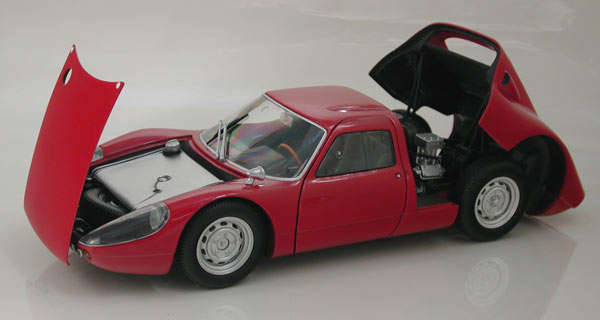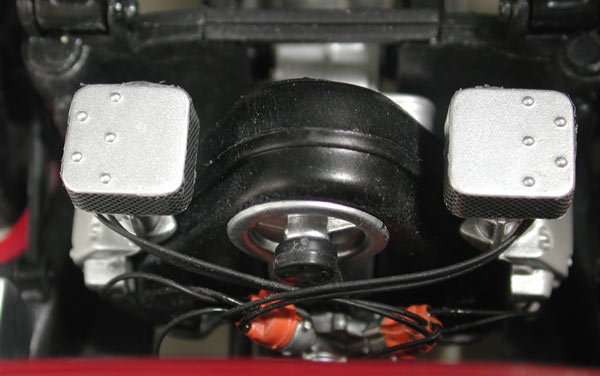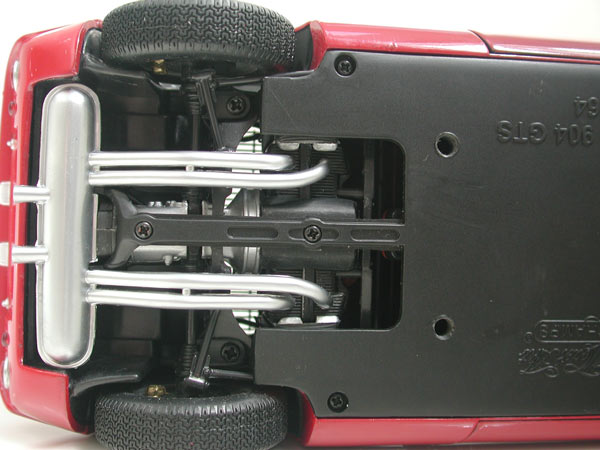1964 Porsche 904 Carrera GTS
Designed
by Ferdinand 'Butzi' Porsche, the 904 looks like a rocket
ship even when standing still. Here was a racing car
designed to be street legal as well. The first 100 were
built in 1964 and fitted with the 4 cylinder, 4 cam Carrera
engine since the 6 cylinder destined for the 911 was not
ready yet.

The
frame was a box structure with the body bonded to it
providing adequate rigidity. The seats were also molded
into the car. Driver accommodations made by a telescoping
steering wheel and adjustable pedals.
The car was delivered to customers with both racing and
street exhaust systems. The racing version at 1433 lbs
would do over 160 MPH, a standing kilometer in 24.5 seconds
and 0-100 km/h (62 MPH) in six seconds.
In 1965 another 20 were produced for use as prototypes with
6 and 8 cylinder engines.
Several of the 904 were called 906 by the factory after
being fitted with 6 and 8 cylinder engines. The 904 had
several features that were troublesome. The fiberglass body
was bonded to a steel subframe. This construction technique
was suspect because any corrosion problems were hidden
under the fiberglass. Further the bodies were made by
spraying chopped fiberglass into a mold. The amount sprayed
varied in thickness and as a result the weight of the
various cars was inconsistent.
Often
referred to as the first of the "modern" Porsches, the 904,
developed in 1963 and first raced in 1964, featured another
"first" for Zuffenhausen, a full fiberglass bodied coupe,
bonded to a steel channel frame. Intended to use the new
boxer six from the then just introduced 911, it wound up
employing the aged Carrera four cam four-cylinder instead.
Even so, this engine was enough to help the 904 dominate
the 2.0-liter production sports car class for Porsche for
the next two years. That success was achieved mainly by
Porsche's customers, the factory concentrated on running a
small fleet of six and eight cylinder powered 904's of its
own in the 2.0-liter prototype category.
As had its customers, the factory came to dominate the
division with its coupes, enjoying nearly total success
from Daytona and Sebring through Le Mans in 1964 and '65.
The only blemish on the 904's record came in 1965 when it
was defeated in the hillclimb arena by Ferrari's Type 166
Dino Spyder. In an attempt to keep the 904 on par with its
Ferrari rival, Dr. Ferdinand Piech, the newly
appointed head of Porsche racing, converted the 904 from a
coupe to an open-topped car. Those efforts were in vain;
however, they led Piech to pursue new directions in design
that would take Zuffenhausen to the top of the sport.


Many
consider the 1964 Porsche 904 GTS to be the most
beautifully styled and elegant Porsche ever produced.
According to published history, this automobile was penned
"freehand" without benefit of wind tunnel design evaluation
or anything like computer graphics by "Butzi" Porsche,
currently head of his own renowned design firm, and son of
the late Ferry Porsche.
Features opening rear deck revealing the original type 547
Carrera 4-cylinder engine nicely detailed including spark
plug wires. The doors also opening showing the "fuzzy" type
seat covering of the original. The front hood (or bonnet)
opens revealing the fuel tank over the spare tire. This is
a great piece of Porsche history captured in diecast or any
Porsche afficiando or lover of "Pre-Computer Era" great
elegantly styled automobiles.


Although
it was officially named Carrera GTS, it opened a new
chapter in Porsche's sporting history under the internal
designation 904. The 904, designed by Ferdinand Alexander
Porsche (known as "Butzi"), anticipated, from a technical
point of view, much that did not become the norm in racing
car manufacturing until later: mixed steel/plastic
construction, low weight, small frontal area. It was the
first Porsche with a plastic body and 100 examples had to
be built in order to qualify for the GT class. This was
followed by a further 20 vehicles, of which 16 were
assembled. The rest provided the parts for the spare parts
store.
The 904 GTS displayed in the Porsche
museum had, as a works car, an eight-cylinder two-liter
engine and joined the line-up at Le Mans in 1964 and in
1965 driven by Mitter/Davis.


Exactly
five months after it was presented, Porsche achieved its
fifth victory in this classic race on 26 April 1964 with
the production 904 at the Targa Florio. Antonio Pucci and
Colin Davis snatched victory ahead of Linge/Balzarini in an
identical 904. Further victories followed: at the Tour de
France, at the 1,000 kilometer race around the Nürburgring,
in the Le Mans 24 hour race and in the following Reims 24
hour race. The 904 proved its roadworthiness at the Monte
Carlo rally in 1965, where Eugen Böhringer still came in
second despite a totally snow-covered course. The 904
fitted with four, six and eight-cylinder engines was not
only a very successful racing car of the early 1960s, to
this day it is still regarded as one of the most
attractive.
In 1965, a
Porsche 904 powered by a 6-cylinder engine finished fourth
at Le Mans, winning the Le Mans handicap and the Index of
Performance. As testament to the role the race plays in the
development of specific Porsche components, the brake
calipers used on the 904, and later on the 906, became
known as "Le Mans calipers".